THE BLIND BUY: A JOURNEY THROUGH THE ZATOICHI SERIES
by Kenneth Kimbrough
PART I – The Tale of Zatoichi
It’s time for me to talk about something very near and dear to my heart—movies. More specifically, Japanese movies. And even more specifically, Japanese swordfighting movies.
Since the front page has been loaded with comics reviews lately (Which is excellent! Keep up the hard work, everyone.), I thought it might be time for me to launch a new series following the exploits of the one, the only, Zatoichi—a blind swordsman just as much expert fighter as he is cunning trickster.
The impetus for this series is the release of the Criterion Collection’s massive Zatoichi box set, which encompasses the twenty-five films produced between 1962-1973 and starring Shintaro Katsu as the titular swordsman. When it comes to the franchise, I am a completely uninitiated neophyte, and I bought the box set based on strong buzz and a glowing recommendation from a fellow cinephile. I do however know one or two things about film. And since it’s a long winter, I invite you to curl up and join me as I take on each of these films one by one. And once I’ve covered the initial twenty-five, I might even cover some of the remakes and spinoffs like Ichi and Blind Fury. And yes, for those of you wondering, there will be spoilers. But think of this as a learning experience, as much of a lesson for you dear reader as it is for me.
The Tale of Zatoichi (1962) is the inaugural film in the franchise. Directed by Kenji Misumi and released the same year as Lawrence of Arabia, To Kill a Mockingbird and King Kong vs. Godzilla, the film is presented in black and white with an aspect ratio of 2.35:1, and like Seven Samurai, Yojimbo, and Harakiri, it’s an entry in the predominantly Japanese genre known as chanbara, or rather “swordfighting.” These period dramas flourished in the 60s with the advent of powerhouse filmmakers like Akira Kurosawa and Masaki Kobayashi, and in many ways it’s analogous in to the Western in the United States. There are many tropes in the genre, and we’ll cover many of them organically in this series, but I feel it’s important to recognize at least a few of these tropes before any meaningful discussion can be had. Trust me, there’s jargon and you’ll want to know these things.
First, these films generally take place in the Edo or Tokugawa period of Japan (roughly 1603-1867, think Shakespeare through the American Civil War), a feudal era characterized by rule of a tightly-structured military class which can be broken down like so: after the Emperor, who’s more of a figurehead, you have the shogun (the military leader and de facto ruler of Japan), followed by the daimyo (lords), then by the samurai (knights), and finally the farmers, merchants and everyone else. This class system often creates conflict in chanbara films as the peasants are tread upon by numerous corrupt and dangerous government officials and lower class criminals alike.
However, even though many chanbara films are period pieces, they’re also a product of their own time—a grief-stricken post-World-War-II Japan still reeling from the effects of the atomic bomb and American occupation. Many of the films revolve around samurai who have become masterless wanderers (ronin), and as such they find themselves veterans reduced to poverty. Angst-ridden, desperate and war-addicted are just a few of the adjectives that could be used to describe some of these characters. As mentioned earlier, some use their power to oppress the peasant class, but others use their power to protect them. Like knights in English poetry and cowboys in American cinema, they’re romanticized heroes specially-equipped to guard the lower classes from those who would prey on them. If you can wrap your head around the history lesson, we should finally be ready to move on to our first film—The Tale of Zatoichi!
 Zatoichi feels his way across a bridge.
Zatoichi feels his way across a bridge.
The film begins with an opening credits montage accompanied by an excellent score from Akira Ifukube, who also scored a little unknown film called Godzilla. You may have heard of it. Anyway, this montage introduces us to our protagonist, Zatoichi and his defining characteristic, his blindness, illustrated when he comes to a narrow bridge and has to crawl in order to feel his way across. I love this small moment because not only does it illustrate Ichi’s defining trait, it raises questions as to how this man could possibly be an expert swordsman. (As an aside, I stick to the term “swordsman” because Zatoichi is not a samurai. He is a masseur with a disability, which places him at the very bottom of the feudal system.)
After the credits, Ichi comes to a local shop and asks for Sukegoro, who we later come to find is the clan leader of the local gangsters or yakuza. But in this scene, Sukegoro is out, so Ichi is led to the back room, where some of the yakuza are gambling. It’s here that we’re first introduced to three recurring elements of the film: Zatoichi’s sense of humor, his heightened senses, and his use of his disability to disarm his opponents. As Ichi takes a seat, the camera pans over to some plum blossoms, which the blind swordsman smells. He then turns his head back to the dice-rolling yakuza and says, “It stinks in here.” Classic. Zatoichi then asks to join the game and says that he’ll deal. Thinking that they can easily win against a blind man, the yakuza agree. But when Ichi tries to put the dice in his cup, they accidentally spill onto the mat instead. The yakuza see this, and gladly place their bets on even. Of course, they win this round.
Zatoichi says he has more money and offers to deal again. And again, the dice spill out of his sleeve onto the mat. Again, everyone makes his bet, this time on odd. But when Ichi reaches for the cup, he finds his dice, and says, “How careless of me. They must have slipped from my sleeve,” and putting them back, he lifts the cup to reveal another set of dice. It’s even. The yakuza call foul, but Ichi protests that the bet was placed on the dice inside the cup, and if they placed bets on the dice outside, then they either don’t know how to play or they’re cheaters themselves. After Ichi collects his winnings, the yakuza send two thugs after him, but Ichi is saved by the arrival of Boss Sukegoro, who welcomes him with generous hospitality.
I feel it’s best if we move forward a little bit because most of the following scenes are there to establish character and other exposition. What is important is the introduction of two major characters, Tate and Otane, a brother and sister respectively who are wrapped up in the local crime gang’s activities. Tate, a yakuza himself, is vying for a higher rank in the organization, and ironically he’s put in charge of seeing to Ichi’s needs—even being instructed to wash the blind man’s loincloth. Throughout the film, he serves as a secondary antagonist and a catalyst for much of the conflict. Otane, on the other hand, is a waitress who was formerly married to one of the clan’s leaders, and she becomes a romantic interest for Ichi later in the film—or rather, he becomes a romantic interest to her, as her affections are unrequited.
In the larger framework of the film, these two are something of polar extremes when compared to Zatoichi himself, who lies somewhere between them. Tate fully embraces his criminal lifestyle and murders and steals without so much as a second thought. But Otane wants to escape it and consequently rise to a respectable class.
And between these two is Zatoichi, who manages to remain respectable despite his social standing but also accepts that he cannot move upwards in a rigid class system. He has done too much to have any pretensions about upward mobility. Thus, he learns to navigate it, feeling his way through life and living on his instincts, both literally and figuratively.
Returning to the main thrust of the film, we eventually learn that there’s a war brewing between Boss Sukegoro and a rival clan leader, Boss Shigezo, who has hired a samurai—Hirate, played by Shigeru Amachi, who’s probably best known for the horror film Jigoku. But Sukegoro states that he’s not worried because he has Zatoichi, which precipitates one of the most memorable scenes in the film. During a meeting amongst Sukegoro’s yakuza, one of the members remarks that Ichi cannot possibly be a good swordsman because he’s, you know, blind. That’s when Ichi pipes in. No one had seen him sitting at the back of the room.
Ichi tells the room that he will take just about any jokes regarding his blindness. It’s a fact he cannot help. But when someone questions his skill as a swordsman, he will not sit idly. So Ichi agrees to show his skill. He positions himself next to a candle and steadily holds it in front of himself, the wick still lit and flickering. And with an almost imperceptible slice of his sword, he cuts the candle perfectly in two—both sides of the wick still flickering when they hit the mat. His point proven, he quietly sheaths his sword back into his cane.
After this scene, Sukegoro attempts to enlist Ichi in the fight against Shigezo’s clan. He offers three ryo—one ryo being the equivalent of a year’s worth of food—at first, but Ichi declines, asking if his life is worth so little. Sukegoro then goes to five and finally agrees to eight. One reading of this scene could be that Ichi is working his charm as a conman again, but an alternate reading might highlight Sukegoro’s utter disregard for the sanctity of human life. To Sukegoro, lives are a commodity, something that can be bought or sacrificed as a means to power. But to Ichi, every life is precious, and none so much as his own.
Unbeknownst to the clan leaders, Ichi and Hirate have struck up a friendship and have begun to have conversations with each other. And after Ichi has agreed to assist Sukegoro, he decides to make a late night visit to Hirate in what is a rather revealing scene between the two men. Talking over a bottle of sake, Ichi learns that Hirate is sick with tuberculosis. He’s a ronin who has fallen on hard times, and at the end of his life, finds himself an honorable and educated man forced by his circumstances to work with gangsters and thieves. There are two things about this scene that I’d like to point out. Hirate is either being immensely gracious by drinking with Zatoichi (remember, Ichi is on the bottom rung of the ladder) or Hirate sees Ichi as an intellectual equal, an exception to normal class boundaries. A third argument could also be made that Hirate sees himself as having fallen to the lowest class. I prefer the second explanation. The other feature of this scene is that it is the only time in the film that we see Zatoichi give a back massage to a main character. Even Tate had to give a back massage to Ichi, and there’s even a joke that this crosses class boundaries. But when Ichi gives a massage to Hirate, it’s an acknowledgement of respect and authority—the only acknowledgement within the entire film.
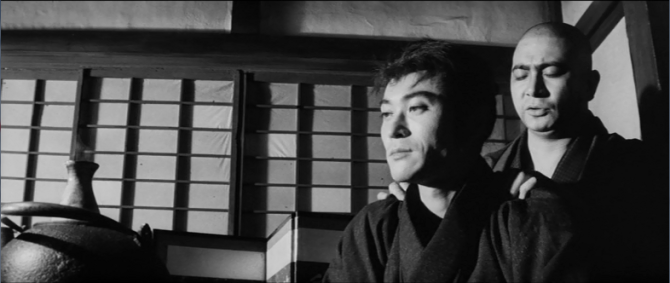 So much is said with a simple gesture.
So much is said with a simple gesture.
In the middle of the visit, Shigezo enters the room and confides that he will strike soon against Sukeguro. Ichi pardons himself, and after he’s gone, Shigezo asks the samurai about his visitor. Hirate explains that the man was Zatoichi, and Shigezo, embarrassed that he had revealed his hand to one of Sukegoro’s agents, dispatches two men to deal with the swordsman. They quickly catch up to Zatoichi, and begin to circle him, which is when Ichi pulls one of the most Daredevil moves in the entire film. Because he was heading back to Sukegoro’s house, Ichi had been carrying a lantern (he had also had a guide, whom he sent away when he heard the men approaching). And when the men arrive, he extinguishes the lantern, leaving them in total darkness. You can probably guess where it goes from here.
The following day, Ichi asks Tate to deliver three good bottles of sake to Hirate. However, Tate pockets most of the money and instead sends two cheap bottles. When the wine merchant goes to deliver the sake, two men attack him and leave his body for Shigezo to find. The gauntlet has been thrown, and Shigezo’s men prepare for war. The way this scene is presented, Tate’s action appears to precipitate the inciting incident for the climactic battle between the rival clans. It almost seems as if his act of greed lights the fire that eventually leads the clans to war, symbolically if not in actuality.
It’s about the same time that Zatoichi saves Otane from being pimped (by Tate of course) to her ex-husband. Thankful for this act, she asks Zatoichi to meet her by the main road so that they can leave together.
This leads us to the final battle, which Zatoichi initially agrees not to be a part of. As Sukegoro’s clan descends on Shigezo’s village, we see the men preparing for war. On Shigezo’s side, Hirate is in bed because he’s too sick to fight, so Boss Shigezo boasts that he’ll use a rifle—the bane of even the most skilled samurai—to deal with Zatoichi, Hirate protests that Ichi doesn’t deserve such an ignominious death. Just as Ichi is blind to Hirate’s fall in status, Hirate is blind to Ichi’s already low status. To Hirate, Ichi is an honorable man among yakuza. So Hirate agrees to fight. Zatoichi thinks similarly, and recognizing that Hirate will not make it through a full-scale battle between the gangs, agrees to face the samurai in single combat.
Although the fight is fairly short, and a description wouldn’t do it justice, it’s a sorrowful and elegiac moment as two men are driven to battle each other. What I can elaborate on is Zatoichi’s unusual fighting style: he tends to use his sword underhand like a cane. It’s truly one of the most interesting fighting styles I’ve seen in a chanbara film, and we’ll get to see more of it in the next installment.
But back to the battle, I’m sure it’s no spoiler to say that Ichi survives. Having killed Shigezo’s champion, the clan soon falls and Zatoichi later finds Boss Sukegoro and Tate laughing and celebrating.
Righteously outraged, Ichi admonishes Sukegoro for his lack of concern for his men. And tossing his payment back at the clan leader’s feet, he goes to see to Hirate’s funeral arrangements. It’s this scene that leads me to believe that there weren’t any sequels planned for Zatoichi. In it, Ichi gives up his sword and it’s presumed violence as well. It’s a bleak ending, but it doesn’t feel at all out of place within the larger narrative of chanbara cinema.
 Zatoichi gives up his cane sword.
Zatoichi gives up his cane sword.
As Zatoichi leaves the village, Tate sneaks up on the swordsman to kill him. But even without his cane, Ichi is still lethal, and he knocks Tate into a nearby river, where he drowns. Ichi cranes his head around and says, “Probably just some worthless nobody.” The film ends with Zatoichi avoiding the main road, where Otane stands waiting. But Ichi avoids her, his back to the camera as he wanders off into the distance.
As for closing thoughts, this film has cemented itself among my favorite chanbara films. Zatoichi is easy to root for, and it’s always entertaining to watch Shintaro Katsu’s portrayal. I’ve already watched the second film, and I can safely say it’s more of what makes this film great. Thank you for joining me. Until next time, don’t play dice with a blind man.
___________________________
Follow Kenneth Kimbrough on Twitter: @KKimbrough44

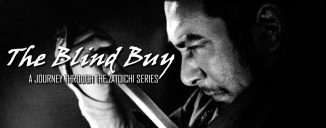
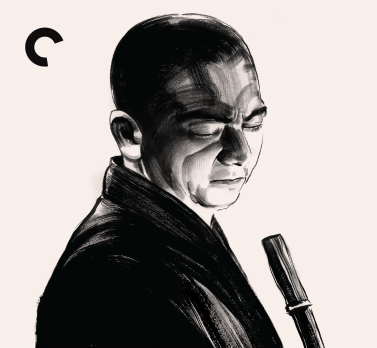


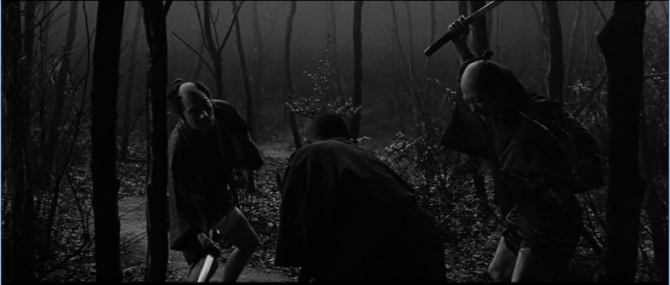
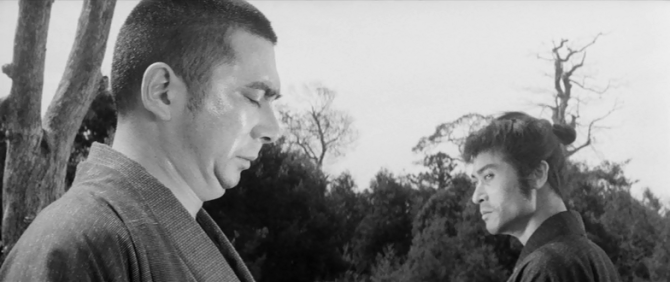
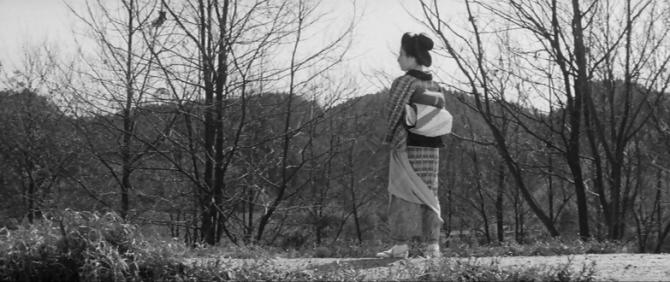
Nicely done! Good observations about Ichi and Hirate’s relationship. I think it’ll be fun for me to follow along with you on this. And thanks for pointing out Zatoichi is “The Blind Swordsman” rather than the “The Blind Samurai”, that’s a pet peeve of mine.
I can easily see why it would be a pet peeve. The crux of the movie is that Ichi is the outsider, lower in class than even the peasant yakuza, and it makes him the underdog. If you can wrap your head around his place in society, you would never refer to him as a samurai. Thanks for reading! I’ll try to have the next one up in a timely fashion.
Pingback: THE BLIND BUY: A Journey Through The ‘ZATOICHI’ Series Part 2 | BAG & BORED